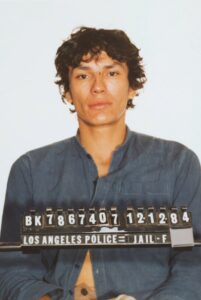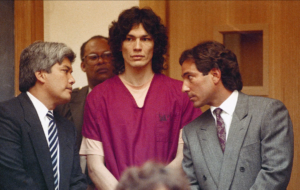The Hunt for the Night Stalker: How the Chase for Richard Ramirez Unfolded
The ghost of “Night Stalker” haunted the cities of San Francisco and Los Angeles during the hot summer of 1985. With terrifying unpredictableness, a rapist, burglar, and sadistic serial killer prowled Southern California. Richard Ramirez, who the media dubbed “The Night Stalker,” left a trail of vicious killings and sexual assaults that defied trends, baffled law enforcement, and frightened locals. His willingness to strike without warning, targeting both genders, children, and adults, across multiple jurisdictions, was what made him particularly hard to apprehend, in addition to the randomness of his attacks.
The terrifying but ultimately victorious true crime tale reflected the persistent investigation, media pressure, and an unanticipated act of community heroism, that finally lead the law enforcement to finally corner and capture Ramirez.
shoe print at the crime scene : actual crime scene footage
A Killer with No Clear Pattern
The murder of 79-year-old Jennie Vincow in her Los Angeles apartment in June 1984 marked the official start of Richard Ramirez’s crime spree. But authorities didn’t start linking a string of vicious assaults under the presumption that one man was behind them until 1985. Extreme violence, sexual assault, and Satanic symbolism were hallmarks of his crimes.
Ramirez had no rituals or victim profiles like other serial killers did. He killed husbands, assaulted women in their homes, abused children, and frequently left pentagrams and other messages of Satan all over the place. Because of his brutality and randomness, he was almost impossible to follow using standard behavioral profiling.
Additionally, Ramirez was mobile; he frequently moved neighborhoods, used stolen vehicles, and left no consistent forensic evidence. His size-11 Avia sneakers, whose imprints were discovered at multiple crime scenes, and the fear he instilled were his only true distinguishing characteristics. In heatwave-stricken California, he targeted homes with open doors and windows, which caused widespread panic. People started arming themselves, purchasing guard dogs, and bolting windows.
Building the Profile
It was difficult for law enforcement to identify a credible suspect. There were several police departments involved, each with unique tactics and constraints. Clues were few because of the lack of coordination and the fact that Ramirez frequently left behind little forensic evidence. However, patterns started to show up over time.
The Los Angeles County Sheriff’s Department detectives, particularly Frank Salerno and Gil Carrillo, were tasked with solving the case. They observed sneaker prints, similar entry points, and random but distinct forms of theft and violence. They had a trail to follow because some items, like jewelry that had been stolen, were being pawned under false identities.
Ramirez’s only significant mistake came when a bracelet that had been pawned was eventually traced back to him using a fingerprint.
you may also like to read “The man who killed 100 boys”

The Breakthrough
A pivotal moment occurred in late August 1985. Ramirez made a serious error. One fingerprint was recovered by police from the rearview mirror of a stolen Toyota he left close to a crime scene in Los Angeles. Although California’s fingerprint database was still in its infancy at the time, it was functional.
Police on August 30, 1985, determined that the print belonged to a drifter named Richard Ramirez, 25, who had a long criminal history that included drug use, theft, and a troubling interest in Satanic literature. Additionally, they had a mugshot from a prior arrest on file.
“This man is to be considered extremely dangerous,” the police warned when they released his photo to the media the following day, August 31.

Richard Ramirez mug shot
The Chase Begins
Ramirez had no idea that his image was now displayed on every television and newspaper in California. He was then on his way back to Los Angeles by bus after visiting his brother in Tucson, Arizona. He was unaware that he was now California’s most wanted man.
On the morning of August 31, Ramirez was recognized by a number of passengers when he got off the Greyhound bus at the Los Angeles station. There were whispers. Panic struck when he saw his face on the front page of a newspaper.
Ramirez ran out of the station after realizing he had been exposed. The streets were now observing him as he tried to carjack a woman. A group of onlookers paid attention when the woman screamed.
Citizen Justice
The ensuing pursuit would become legendary. Residents started to crowd in on Ramirez as he ran through the neighborhood, attempting to steal several cars and get away. He climbed fences and ran through yards, but more and more people were pursuing him.
Ramirez once tried to carjack Faustino Pinon. A few locals had caught up by the time Ramirez dragged the man from his vehicle. Nestor Montoya, one of the men, struck Ramirez over the head with a metal bar. He was tackled to the ground by another onlooker. A crowd soon gathered, beating Ramirez and detaining him until the police could come.

Richard Ramirez during the trial in court room
Ramirez was bloodied, stunned, and not the frightful man who had plagued the city when police arrived on the scene. East LA residents had accomplished what no police force could: they had apprehended the Night Stalker.
The Trial of the Century
A 14-month nightmare came to an end with Ramirez’s arrest, but the legal proceedings would be yet another drawn-out ordeal. Due to a number of legal setbacks, including problems with his mental health assessments, defense motions, and jury issues, his trial didn’t start until 1989.




Pingback: Doctor Death : Serial killer Dr Harold Shipman’s - True Crime